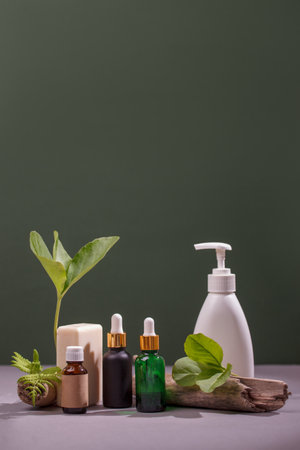Introduction: Redefining Beauty with Sustainability
Over the past decade, sustainability has transformed from a buzzword into a driving force within the American skincare industry. What was once a niche concern for eco-conscious consumers has now become a mainstream expectation, reshaping how beauty is defined and experienced. Today’s consumers aren’t just seeking products that promise glowing skin—they’re also demanding transparency, ethical sourcing, and environmental responsibility. This cultural shift reflects broader changes in American values, where individual self-expression is intertwined with collective responsibility for our planet. As brands respond to this evolving landscape, sustainability is no longer an afterthought but an integral part of brand identity and consumer decision-making. The result? A beauty standard that celebrates not only personal well-being but also the health of our communities and environment.
2. Early Days: Sustainability as a Niche Movement
In the early days of sustainable skincare, the movement was far from the mainstream buzzword it is today. It began on the fringes—driven by passionate individuals and small indie brands who believed in doing business differently. This grassroots ethos set the foundation for a shift that would eventually redefine beauty standards across the industry.
The Roots of Sustainable Skincare
Long before “green” became a marketing must-have, eco-conscious consumers were seeking out alternatives to conventional products. These early adopters were often well-informed about environmental issues and deeply committed to ethical consumerism. Their choices were guided by personal values rather than trends, and their voices, though small, were persistent enough to inspire change.
Pioneering Indie Brands
Small indie brands led the way, prioritizing transparency, ethical sourcing, and minimal packaging when these concepts were still considered radical. Operating out of kitchens, garages, and local markets, these founders put their heart into every batch—often hand-labeling products and engaging directly with customers. The table below highlights some defining characteristics of these early pioneers:
| Aspect | Traditional Skincare | Early Sustainable Skincare |
|---|---|---|
| Sourcing | Mass-produced, global supply chains | Locally-sourced, fair trade ingredients |
| Packing | Single-use plastics, non-recyclable materials | Minimalist, recyclable or reusable packaging |
| Production Scale | Large-scale manufacturing | Small batch, artisanal production |
The Grassroots Ethos
This early movement was characterized by authenticity and activism. Community was everything; education happened through workshops at co-ops or community centers rather than glossy ad campaigns. The ethos was simple: respect for nature and people over profits.
A Foundation for Change
Though initially niche, these trailblazers planted seeds that would grow into a collective consciousness about sustainability in beauty. Their commitment paved the way for today’s broader acceptance—and expectation—of responsible skincare practices.
![]()
3. Consumer Awareness and Demand
In recent years, American consumers have become increasingly aware of the environmental impact of their everyday choices—including the skincare products they use. This shift is deeply intertwined with growing access to information and a cultural movement that values transparency and responsibility. Social media platforms like Instagram, TikTok, and YouTube play a pivotal role in this transformation. Through these channels, influencers and everyday users alike share personal stories, product reviews, and educational content about sustainability, often using hashtags such as #CleanBeauty and #EcoFriendlySkinCare to amplify their message.
This surge in visibility has empowered consumers to ask more questions about the origins of ingredients, packaging materials, and ethical business practices. Skincare brands are now held accountable by an audience that can instantly fact-check or voice concerns online. Influencer culture further accelerates this trend: when trusted voices highlight greenwashing or praise truly sustainable initiatives, followers take note—and often change their buying habits accordingly.
Moreover, social media isn’t just a place for sharing—it’s a powerful tool for advocacy. Grassroots campaigns encouraging cruelty-free testing, carbon-neutral shipping, or refillable packaging gain momentum quickly in American digital spaces. As a result, demand for eco-friendly and ethically produced skincare has moved from being a niche concern to becoming mainstream consumer expectation. The evolution of awareness and demand illustrates how collective action and digital connectivity are reshaping the landscape of American skincare—one post, comment, and purchase at a time.
4. Mainstream Adoption: Big Brands and Mass Retailers Join In
The journey of sustainability in skincare took a major leap when established companies and mass retailers decided to embrace the movement. No longer just a niche concern, sustainability became an industry priority as household names recognized both the ethical imperative and consumer demand for more responsible choices. This shift didn’t happen overnight; it required large-scale innovation, investment, and a willingness to rethink traditional business models.
Major brands like LOréal, Unilever, and Procter & Gamble started weaving sustainability into their product development, from sourcing raw materials ethically to using recycled packaging. These companies began promoting transparency by sharing ingredient sourcing, carbon footprints, and progress toward corporate social responsibility goals. At the same time, mass retailers such as Target, Walmart, and Ulta launched dedicated sections for sustainable skincare products and partnered with third-party certifications like EWG Verified and Leaping Bunny to build trust with customers.
Key Strategies Adopted by Industry Leaders
| Brand/ Retailer | Sustainable Product Initiatives | Supply Chain Changes | Marketing Approaches |
|---|---|---|---|
| LOréal | Biodegradable formulas, refillable packaging | Ethical sourcing, reduced water usage in manufacturing | Emphasis on “green science,” transparent reporting |
| Unilever | Vegan and cruelty-free lines | Commitment to net-zero emissions across supply chain | Clear labeling, sustainability storytelling in ads |
| Target (Retailer) | “Target Clean” curated selection of clean beauty brands | Supplier guidelines for eco-friendly packaging | Shelf tags highlighting sustainable options in-store |
| Ulta Beauty (Retailer) | Diversity in sustainable product assortment | Partnerships with brands focused on upcycling ingredients | Sustainability education campaigns for shoppers |
Making Sustainability Accessible for All
The integration of sustainable practices by these power players has made eco-conscious skincare accessible far beyond early adopters. With increased shelf space in mainstream stores and competitive pricing strategies, consumers from all backgrounds can now make greener choices without sacrificing convenience or efficacy. As a result, sustainability is no longer an “elite” option but part of the everyday beauty conversation in America.
5. Challenges and Ongoing Controversies
As sustainability becomes a central theme in the U.S. skincare market, new challenges and controversies have emerged, fueling passionate debates among consumers, beauty experts, and brands alike.
Greenwashing: The Fine Line Between Marketing and Reality
One of the most persistent issues is greenwashing—the practice where brands exaggerate or falsely claim eco-friendly credentials to attract conscious consumers. In the American beauty landscape, terms like “natural,” “clean,” and “sustainable” are often loosely defined, leading to confusion and skepticism. Shoppers are increasingly wary of buzzwords that seem more about boosting sales than genuinely reducing environmental impact.
Transparency Matters More Than Ever
Transparency has become a rallying cry across U.S. consumer circles. People want to know not just what’s inside their products, but also how those ingredients were sourced, manufactured, and packaged. Brands that provide detailed ingredient lists, third-party certifications, and clear supply chain information tend to earn greater trust. However, delivering this level of openness can be challenging for companies navigating complex global supply networks.
The Effectiveness vs. Eco-Friendliness Debate
Another ongoing controversy centers around the perceived trade-off between product performance and environmental responsibility. Some American consumers worry that sustainable options might not deliver the same visible results as traditional formulations. This tension pushes brands to innovate—creating effective products that don’t compromise on ecological values—but also sparks discussions about what compromises are truly acceptable in the name of sustainability.
The Path Forward: Accountability and Education
Ultimately, addressing these challenges requires a collaborative effort. U.S.-based advocacy groups continue to push for stricter regulations and clearer definitions, while consumers educate themselves through social media, forums, and reviews. By demanding authenticity and holding brands accountable, Americans are shaping a more transparent—and truly sustainable—future for skincare.
6. Looking Ahead: The Future of Sustainability in Skincare
As we look to the future, the sustainability movement in skincare is poised for even more dynamic growth and transformation. American consumers are becoming increasingly conscious of how their self-care routines impact the planet, and this awareness is shaping both purchasing decisions and brand innovation. The next wave of sustainable skincare will likely be driven by a combination of emerging technologies, evolving values, and heightened expectations for transparency and accountability.
Next-Gen Ingredients & Packaging
In the years ahead, we can expect to see significant advancements in biotechnology and green chemistry, leading to the development of high-performance, nature-inspired ingredients that have minimal environmental impact. Biodegradable packaging, refillable containers, and zero-waste designs will become standard rather than exceptional, as brands respond to growing consumer demand for reduced plastic use and circular economy solutions.
Personalization & Inclusivity
Sustainable skincare will also become more personalized and inclusive. Data-driven customization will allow people to choose products tailored specifically to their skin’s needs while minimizing waste. Brands will continue to expand shade ranges, formulations, and messaging to authentically reflect the diversity of the American community—making sustainability not just an environmental priority but a social one as well.
The Role of Technology & Community
Digital tools—from blockchain-based ingredient tracing to AI-powered product recommendations—will empower consumers with more information than ever before. Online communities will continue to hold brands accountable, amplifying voices that demand ethical sourcing, fair labor practices, and real commitments rather than greenwashing.
A Shift in Values: From Consumerism to Conscious Self-Care
The American approach to beauty is shifting from simple consumerism toward conscious self-care. People are seeking products that align with their values, foster well-being, and support broader environmental and social change. As sustainability becomes deeply woven into the fabric of everyday life, it’s clear that what was once niche has become not only mainstream but essential—a testament to our collective power to shape a healthier future for ourselves and our planet.

